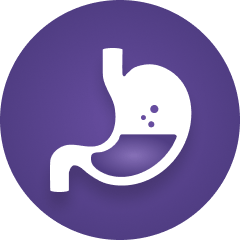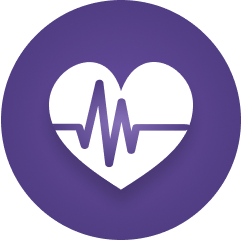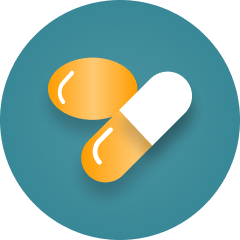GOMEKLI has a manageable safety profile in adults with NF1-PN*

The majority of adverse reactions in ReNeu were mild to moderate1
Adverse reactions (≥20%) in adult patients who received GOMEKLI (n=58)1
All grades
Grade 3 or 4†
Skin and subcutaneous tissue disorders
Rash‡
10%
Gastrointestinal disorders
Diarrhea§
59%
0%
Nausea
52%
0%
Vomiting
38%
0%
Abdominal painǁ
24%
3%
Musculoskeletal and connective tissue disorders
Musculoskeletal pain¶
41%
5%
General disorders and administration site conditions
Fatigue
29%
2%
Infections and infestations
COVID-19#
22%
5%
Nervous system disorders
Peripheral neuropathy**
21%
0%
Low rates of severe (Grade 3) reactions were observed with GOMEKLI.1
GOMEKLI has no contraindications.1
†All reactions were Grade 3 except one fatal case of COVID-19 in an adult.
‡Rash includes dermatitis acneiform, eczema, maculo-papular rash, pustular rash, dermatitis, erythematous rash, palmar-plantar erythrodysesthesia syndrome, exfoliative rash, skin exfoliation, pruritic rash, papule, papular rash, and macular rash.
§Diarrhea includes frequent bowel movements.
ǁAbdominal pain includes upper abdominal pain, gastrointestinal pain, and abdominal discomfort.
¶Musculoskeletal pain includes noncardiac chest pain, back pain, pain in extremity, neck pain, musculoskeletal chest pain, myalgia, arthralgia, and bone pain.
#Includes one fatal case in an adult.
**Peripheral neuropathy includes paresthesia, hypoesthesia, neuralgia, and peripheral sensory neuropathy.
NF1-PN=neurofibromatosis type 1 with plexiform neurofibromas.
Laboratory abnormalities
Select laboratory abnormalities (≥15%) that worsened from baseline in adult patients who received GOMEKLI in ReNeu (n=58)1,††,‡‡
All grades
Chemistry
Increased creatine phosphokinase
55%
4%
Increased triglycerides
29%
0%
Decreased calciumǁ ǁ
23%
0%
Increased cholesterol
23%
0%
Increased aspartate
aminotransferase (AST)
18%
0%
Hematology
Decreased hemoglobin
21%
0%
Decreased lymphocytes
16%
0%
††The denominator used to calculate the rate was 56 based on the number of patients with a baseline value and at least 1 posttreatment value.
‡‡Graded per NCI-CTCAE version 5.0.
§§No Grade 5 laboratory abnormalities were reported in the ReNeu study.
ǁǁCalcium corrected for albumin (mmol/L).
CTCAE=Common Terminology Criteria for Adverse Events; NCI=National Cancer Institute.
Helping patients stay on track
Helping patients stay on track
[Title builds on purple background with GOMEKLI logo in top right corner.]
Text onscreen:
Chapter 1: Getting ready for GOMEKLI
Voice-over:
Dr. Weintraub: Hello. I’m Dr. Lauren Weintraub, a hematologist and oncologist specializing in pediatric cancers and blood disorders.
Text onscreen:
Lauren Weintraub, MD
Dr. Nghiemphu: And I’m Dr. Phioanh Leia Nghiemphu, a neuro-oncologist specializing in neurofibromatosis and brain tumors in adults. Today we’re going to talk about GOMEKLI and how to help patients adhere to their treatment regimen over time.
Text onscreen:
Phioanh Leia Nghiemphu, MD
Dr. Weintraub: GOMEKLI is the first FDA-approved treatment for both adults and children 2 years of age and older with neurofibromatosis type 1 who have symptomatic plexiform neurofibromas that are not amenable to complete resection. Important Safety Information for GOMEKLI will be presented later in this video.
Text onscreen:
GOMEKLI is the first FDA-approved treatment for both adults and children 2 years of age and older with neurofibromatosis type 1 (NF1) who have symptomatic plexiform neurofibromas (PN) that are not amenable to complete resection.
Dr. Nghiemphu: GOMEKLI was evaluated in the ReNeu trial, a large phase 2b, single-arm study that included both adults and children with NF1-PN and lasted for about 2 years and included an optional long-term follow-up phase.
Image onscreen:
Study design graphic
Dr. Nghiemphu: The primary endpoint was confirmed overall response rate, defined as the proportion of patients with a 20% or greater reduction in plexiform neurofibroma volume, as shown on 2 consecutive MRI scans.
Image onscreen: Graphic representation of primary endpoint for both adult and pediatric patients
Dr. Nghiemphu: 41% of adult patients—or 24 out of 58—achieved a confirmed overall response. And 52% of pediatric patients—or 29 out of 56—achieved a confirmed overall response.
Dr. Weintraub: NF1 is a lifelong condition and PNs may require long-term management, so it’s important for patients to understand the short- and long-term treatment experience with GOMEKLI. This presents the opportunity for us to adapt how we support patients, as their needs may change throughout their treatment journey with GOMEKLI.
Text onscreen:
Chapter 2: The early months of treatment
Voiceover:
Dr. Weintraub: When patients start on a long-term treatment like GOMEKLI, I like to sit down with them and their caregivers to set expectations about what those first few months of treatment may look like, including the potential side effects. It’s quite possible that they’ll experience side effects before their plexiform neurofibromas change, and I want them to be prepared for that.
Dr. Nghiemphu: That’s true. While some patients in ReNeu started to experience symptom improvement within a few months on treatment, the median time to onset of confirmed response with GOMEKLI was 7.8 months for adults and 7.9 months for pediatric patients. However, adverse reactions typically occur earlier in the treatment journey.
Image onscreen:
Chart of adult adverse reactions
Dr. Nghiemphu: In ReNeu, the most commonly-reported adverse reactions in both adults and children were rash, diarrhea, nausea, musculoskeletal pain, and vomiting. Fatigue was also reported in adults. Abdominal pain, headache, paronychia, and left ventricular dysfunction were also reported in children.
The most common severe lab abnormalities were increased creatine phosphokinase, or CPK, in both adults and children and decreased neutrophil count in children.
Image onscreen:
Chart of pediatric adverse reactions
Dr. Nghiemphu: Serious side effects associated with GOMEKLI include eye problems, heart problems, skin problems, and embryo-fetal toxicity.
Dr. Weintraub: For me, it’s important to set my patients’ expectations. While they may experience side effects during GOMEKLI treatment, they can—and should—absolutely reach out to me if that happens. I want them to know that this is a safe space for them, and they don’t have to deal with side effects on their own. It’s about making them comfortable enough to discuss what they’re experiencing and tailoring their treatment accordingly.
Dr. Nghiemphu: I also think patients are less discouraged by side effects if they know when they’re likely to occur and that there are ways to manage them. When I talk with patients about skin rash, I tell them: Of those who had skin-related side effects in ReNeu, the majority experienced first onset during Cycle 1—or the first month—of treatment.
Text onscreen:
Of the patients who had dermatologic adverse reactions, the majority (80%) experienced first onset during Cycle 1 of treatment.
Dr. Nghiemphu: I tell them that being proactive with skincare can go a long way. Initiating a prophylactic regimen concurrently with the start of GOMEKLI can help mitigate skin-related adverse reactions.
In addition, I usually suggest daily baths and the use of mild cleansers and skin moisturizers at least twice a day to prevent dryness. I might suggest avoiding certain products that could dry out or irritate the skin.
I also make sure my patients have access to a dermatologist. Since dermatologic adverse reactions are common with GOMEKLI, collaborating with specialists allows us to proactively manage side effects before they become severe.
Dr. Weintraub: I couldn’t agree more. There’s an added challenge with the pediatric population since the types of rashes that develop can depend on the age of the patient. For my young patients, rash tends to be less of an issue, so I don’t necessarily use prophylactic measures. For my preadolescent patients, the acneiform rash can be a major issue, so I prescribe topical therapy for them to have on hand. I also lean on my dermatology colleagues for help because the types of rashes can vary and are sometimes unresponsive to standard therapies.
I have a 12-year-old patient who developed acneiform rash and was very upset about it. I started him on a medication for the rash, and it was working, but I had a backup treatment planned in case it didn’t. I also referred him to a dermatologist in case neither treatment plan worked. I called the dermatologist and explained what NF1-PN is and what my concerns were, and sent him some data so he’d be prepared in case this patient came in.
Being in a more rural area, there’s a bit more education required for other specialists involved in care. They may have never heard of NF1-PN or be familiar with MEK inhibitors and the associated side effects.
Dr. Nghiemphu: I appreciate how proactive you were in setting up that dermatology referral early, so the patient wouldn’t have to wait too long to get an appointment.
Gastrointestinal adverse reactions were also common in the ReNeu trial.
Text onscreen:
Of the patients who had GI adverse reactions in ReNeu, the majority experienced first onset early (Cycles 1-3).
Dr. Nghiemphu: For both adult and pediatric patients, first onset of gastrointestinal reactions were seen during the first 3 cycles of treatment.
Image onscreen:
Chart showing proportion of adult and pediatric patients experiencing GI reactions in first 2 cycles of treatment
Dr. Nghiemphu: To help mitigate side effects like diarrhea, nausea, or vomiting, I advise patients to adjust their diet to avoid fried, fatty, or spicy foods, as well as to increase fluid intake. When they start treatment, I also recommend that they get an over-the-counter antidiarrheal medication, so they have it readily available in case a side effect occurs. As with dermatologic side effects, prophylaxis can be helpful.
Dr. Weintraub: In addition to managing the side effects, it’s important for patients and caregivers to know that interrupting or reducing their GOMEKLI dose is also an option. And if side effects continue after those dose adjustments, we have the option to permanently stop GOMEKLI. For me personally, open and honest conversations with my patients are key. When I know what a patient is experiencing, I can help them navigate through any side effects.
The GOMEKLI Dosing and Adverse Reaction Management Guide is a great resource that includes guidance on managing adverse reactions that occur during treatment. It is available for download at GOMEKLI.com/hcp.
Image onscreen:
Animated Dosing and Adverse Reaction Management Guide and QR code
Text onscreen:
Chapter 3: Long-term needs of patients of taking GOMEKLI
Dr. Nghiemphu: As we discussed earlier, patients may be on a longer treatment journey with GOMEKLI. Sometimes when they’ve been on a medication for a long period, it may be challenging to stay as diligent as at the start of treatment. Let's review some relevant data: As shown in a post hoc exploratory analysis, 62% of adult responders and 52% of pediatric responders achieved a deep response, meaning their target plexiform neurofibroma decreased by more than 50% from baseline.
Image onscreen:
Animation of post hoc exploratory data for adult and pediatric patients
Dr. Nghiemphu: I find it interesting that across both cohorts, patients who achieved a deep response were on GOMEKLI treatment for a longer duration of time than those who did not. That’s why I emphasize to my patients that staying on track with treatment helps increase their chance of benefiting from GOMEKLI.
Text onscreen:
GOMEKLI treatment should be continued until disease progression or unacceptable toxicity
Dr. Weintraub: If you recall, I spoke earlier about a young patient who was experiencing rash. He was so upset he was ready to quit treatment. But while he was focused on the rash, his mother was seeing his plexiform neurofibroma getting softer and smaller. She helped him to recognize the long-term benefits of staying on treatment, and in the meantime, we were able to work through the side effects so he could do just that. I’m always grateful to have parents and caregivers who are so engaged in their child’s care and who help keep them on track with treatment.
In addition to talking about study results, I think it’s helpful for young patients to hear anecdotes like that one. They relate more to stories about what other patients have experienced than to numbers on a page. Although every patient's experience is different, I tell them I have patients who I’ve been treating with GOMEKLI for 5 years, ever since they were first enrolled in the ReNeu trial.
Dr. Nghiemphu: What would you say to a provider who has not prescribed GOMEKLI yet and does not have any of these personal anecdotes to share?
Dr. Weintraub: That’s a great question! I think it goes back to that collaboration we talked about earlier: Reaching out to your colleagues is key. With a complex condition like NF1-PN, you can’t work in a silo. I know we’re all data-driven individuals, but it’s so helpful to hear about the firsthand experience of your peers.
Dr. Nghiemphu: In addition to staying adherent to their treatment regimen, we also want to make sure that patients are coming to their regular appointments. Even if they’re not experiencing symptoms, and their side effects are being managed, regular follow-ups allow me to properly assess their health and make sure things are going well.
Dr. Weintraub: Having a multidisciplinary pediatric clinic definitely makes that easier. We have a support staff that includes NF coordinators, nurses, and case managers all helping to make sure patients follow up with their appointments and get the care they need. We also have a child-life specialist who supports children with the physical challenges that plexiform neurofibromas can bring. Recently, she visited a school to help a patient’s classmates better understand NF1-PN and foster a more supportive, inclusive environment.
Dr. Nghiemphu: Of course, not every clinic has these same resources, and care for adult patients is limited due to the lack of adult NF clinics. For some, even the closest clinic with a multidisciplinary team might still be hard to get to; that's why it's important for clinicians’ offices to meet patients where they are and be flexible with the care model. For patients who live far away, working with a local healthcare provider can help so they don’t have to travel a long distance all the time. If permitted, I sometimes offer virtual visits. If it’s a follow-up to go over lab results, meeting virtually is sufficient and helps ease the travel burden.
Dr. Weintraub: I totally agree. Adapting to a patient’s needs sets the foundation for productive doctor-patient interactions and builds trust. Our patients—no matter how young or old they are—rely on us. And what a great note to end on! Thank you for listening to us discuss how we support patients throughout their treatment journey with GOMEKLI, and be sure to check out the GOMEKLI website for resources for both your practice and patients.
Text onscreen:
Additional videos and resources to support your practice and your patients are on GOMEKLI.com/hcp.
Image onscreen:
QR code
Voiceover:
Indication
GOMEKLI (mirdametinib) is indicated for the treatment of adult and pediatric patients 2 years of age and older with neurofibromatosis type 1 (NF1) who have symptomatic plexiform neurofibromas (PN) not amenable to complete resection.
Important Safety Information
Warning and Precautions
Ocular Toxicity: GOMEKLI can cause ocular toxicity including retinal vein occlusion (RVO), retinal pigment epithelium detachment (RPED), and blurred vision. In the adult pooled safety population, ocular toxicity occurred in 28% of patients treated with GOMEKLI: 21% were Grade 1, 5% were Grade 2 and 1.3% were Grade 3. RVO occurred in 2.7%, RPED occurred in 1.3%, and blurred vision occurred in 9% of adult patients. In the pediatric pooled safety population, ocular toxicity occurred in 19% of patients: 17% were Grade 1 and 1.7% were Grade 2. Conduct comprehensive ophthalmic assessments prior to initiating GOMEKLI, at regular intervals during treatment, and to evaluate any new or worsening visual changes such as blurred vision. Continue, withhold, reduce the dose, or permanently discontinue GOMEKLI as clinically indicated.
Left Ventricular Dysfunction: GOMEKLI can cause left ventricular dysfunction. GOMEKLI has not been studied in patients with a history of clinically significant cardiac disease or LVEF <55% prior to initiation of treatment. In the ReNeu study, decreased LVEF of 10 to <20% occurred in 16% of adult patients treated with GOMEKLI. Five patients (9%) required dose interruption, one patient (1.7%) required a dose reduction, and one patient required permanent discontinuation of GOMEKLI. The median time to first onset of decreased LVEF in adult patients was 70 days. Decreased LVEF of 10 to <20% occurred in 25%, and decreased LVEF of ≥20% occurred in 1.8% of pediatric patients treated with GOMEKLI. One patient (1.8%) required dose interruption of GOMEKLI. The median time to first onset of decreased LVEF in pediatric patients was 132 days. All patients with decreased LVEF were identified during routine echocardiography, and decreased LVEF resolved in 75% of patients. Before initiating GOMEKLI, assess ejection fraction (EF) by echocardiogram. Monitor EF every 3 months during the first year and then as clinically indicated. Withhold, reduce the dose, or permanently discontinue GOMEKLI based on severity of adverse reaction.
Dermatologic Adverse Reactions: GOMEKLI can cause dermatologic adverse reactions including rash. The most frequent rashes included dermatitis acneiform, rash, eczema, maculo-papular rash and pustular rash. In the pooled adult safety population, rash occurred in 92% of patients treated with GOMEKLI (37% were Grade 2 and 8% were Grade 3) and resulted in permanent discontinuation in 11% of patients. In the pooled pediatric safety population, rash occurred in 72% of patients treated with GOMEKLI (22% were Grade 2 and 3.4% were Grade 3) and resulted in permanent discontinuation in 3.4% of patients. Initiate supportive care at first signs of dermatologic adverse reactions. Withhold, reduce the dose, or permanently discontinue GOMEKLI based on severity of adverse reaction.
Embryo-Fetal Toxicity: GOMEKLI can cause fetal harm when administered to a pregnant woman. Verify the pregnancy status of females of reproductive potential prior to the initiation of GOMEKLI. Advise pregnant women and females of reproductive potential of the potential risk to a fetus. Also advise patients to use effective contraception during treatment with GOMEKLI and for 6 weeks after the last dose (females) or 3 months after the last dose (males).
Adverse Reactions
The most common adverse reactions (>25%) in adult patients were rash (90%), diarrhea (59%), nausea (52%), musculoskeletal pain (41%), vomiting (38%), and fatigue (29%). Serious adverse reactions occurred in 17% of adult patients who received GOMEKLI. The most common Grade 3 or 4 laboratory abnormality (>2%) was increased creatine phosphokinase.
The most common adverse reactions (>25%) in pediatric patients were rash (73%), diarrhea (55%), musculoskeletal pain (41%), abdominal pain (39%), vomiting (39%), headache (34%), paronychia (32%), left ventricular dysfunction (27%), and nausea (27%). Serious adverse reactions occurred in 14% of pediatric patients who received GOMEKLI. The most common Grade 3 or 4 laboratory abnormalities (>2%) were decreased neutrophil count and increased creatine phosphokinase.
Use in Specific Populations
Verify the pregnancy status of patients of reproductive potential prior to initiating GOMEKLI. Due to the potential for adverse reactions in a breastfed child, advise patients not to breastfeed during treatment with GOMEKLI and for 1 week after the last dose.
To report SUSPECTED ADVERSE REACTIONS, contact SpringWorks Therapeutics Inc. at 1-888-400-7989 or FDA at 1-800-FDA-1088 or www.fda.gov/medwatch.
Please see full Prescribing Information, including Patient Information and Instructions for Use.
Image onscreen:
GOMEKLI and SpringWorks logos
Text onscreen:
@2025 SpringWorks Therapeutics, Inc. All rights reserved. GOMEKLI is a registered trademark of SpringWorks Therapeutics, Inc. C_GOM_US_0414 8/25
Drs. Weintraub and Nghiemphu discuss how to help patients adhere to their GOMEKLI treatment regimen over time.
Additional information on select adverse reactions
- Rash (all grades) was reported in 90% of adult patients and 10% had Grade 3 rash1
- Rash includes dermatitis acneiform, eczema, maculo-papular rash, pustular rash, dermatitis, erythematous rash, palmar-plantar erythrodysesthesia syndrome, exfoliative rash, skin exfoliation, pruritic rash, papule, papular rash, and macular rash1
- Supportive care should be initiated at first signs of dermatologic adverse reactions. GOMEKLI should be withheld, dose reduced, or permanently discontinued based on severity of adverse reaction1

- The GI adverse reactions reported in ≥20% of patients in the adult cohort were diarrhea (59%), nausea (52%), vomiting (38%), and abdominal pain (24%)1
- There were no Grade ≥3 cases of diarrhea, nausea, or vomiting reported; 3% of patients had Grade 3 abdominal pain1
Diarrhea
71% (24/34)
Nausea
80% (24/30)
Vomiting
55% (12/22)
Abdominal pain
43% (6/14)
GI=gastrointestinal.

- 3 patients in the adult cohort of ReNeu reported blurred vision3
- Retinal pigment epithelium detachment (RPED) occurred in 1 adult patient1
-
Retinal vein occlusion (RVO) occurred in 2.7% of adult patients, including one Grade 3 case that was diagnosed on Day 130 and resulted in permanent treatment discontinuation1,2
- Confounding factors: Grade 3 RVO occurred 4 months after patient initiated hormonal contraception and 9 days after receiving a COVID-19 vaccination3
- No cases of uveitis, optic neuropathy, or retinopathy were reported2
- Conduct comprehensive ophthalmic assessments prior to initiating GOMEKLI, at regular intervals during treatment, and to evaluate any new or worsening visual changes such as blurred vision. Continue, withhold, reduce the dose, or permanently discontinue GOMEKLI based on severity of adverse reaction1

- GOMEKLI has not been studied in patients with a history of clinically significant cardiac disease or left ventricular ejection fraction (LVEF) <55% prior to initiation of treatment1
Decreased LVEF of 10% to <20% occurred in 16% of adult patients treated with GOMEKLI1
- Of the patients with decreased LVEF, 5 (9%) required dose interruption, 1 (1.7%) required a dose reduction, and 1 patient required permanent discontinuation of GOMEKLI
- The median time to first onset of decreased LVEF was 70 days1
- No cases of cardiac failure were reported in the adult cohort2
- Assess ejection fraction by echocardiogram prior to initiating treatment, every 3 months during the first year, then as clinically indicated thereafter. Withhold, reduce dose, or permanently discontinue GOMEKLI based on severity of adverse reaction1
Managing adverse reactions
Dose interruption, reduction, and discontinuation due to adverse reactions1
Adverse reactions that required dose interruption in ≥5% of patients included left ventricular dysfunction and COVID-19. Adverse reactions that required dose reduction in ≥5% of patients included rash.
permanently discontinued treatment
Adverse reactions that resulted in permanent discontinuation of GOMEKLI in ≥1% of patients were rash, diarrhea, nausea, abdominal pain, alopecia, dry skin, left ventricular dysfunction, cough, wheezing, COVID-19, peripheral swelling, retinal vein occlusion, dizziness, and vomiting.

Dosing designed with patient needs in mind
Indication
GOMEKLI (mirdametinib) is indicated for the treatment of adult and pediatric patients 2 years of age and older with neurofibromatosis type 1 (NF1) who have symptomatic plexiform neurofibromas (PN) not amenable to complete resection.
Important Safety Information
Warnings and Precautions
Ocular Toxicity: GOMEKLI can cause ocular toxicity including retinal vein occlusion (RVO), retinal pigment epithelium detachment (RPED), and blurred vision. In the adult pooled safety population, ocular toxicity occurred in 28% of patients treated with GOMEKLI: 21% were Grade 1, 5% were Grade 2 and 1.3% were Grade 3. RVO occurred in 2.7%, RPED occurred in 1.3%, and blurred vision occurred in 9% of adult patients. In the pediatric pooled safety population, ocular toxicity occurred in 19% of patients: 17% were Grade 1 and 1.7% were Grade 2. Conduct comprehensive ophthalmic assessments prior to initiating GOMEKLI, at regular intervals during treatment, and to evaluate any new or worsening visual changes such as blurred vision. Continue, withhold, reduce the dose, or permanently discontinue GOMEKLI as clinically indicated.
Left Ventricular Dysfunction: GOMEKLI can cause left ventricular dysfunction. GOMEKLI has not been studied in patients with a history of clinically significant cardiac disease or LVEF <55% prior to initiation of treatment. In the ReNeu study, decreased LVEF of 10 to <20% occurred in 16% of adult patients treated with GOMEKLI. Five patients (9%) required dose interruption, one patient (1.7%) required a dose reduction, and one patient required permanent discontinuation of GOMEKLI. The median time to first onset of decreased LVEF in adult patients was 70 days. Decreased LVEF of 10 to <20% occurred in 25%, and decreased LVEF of ≥20% occurred in 1.8% of pediatric patients treated with GOMEKLI. One patient (1.8%) required dose interruption of GOMEKLI. The median time to first onset of decreased LVEF in pediatric patients was 132 days. All patients with decreased LVEF were identified during routine echocardiography, and decreased LVEF resolved in 75% of patients. Before initiating GOMEKLI, assess ejection fraction (EF) by echocardiogram. Monitor EF every 3 months during the first year and then as clinically indicated. Withhold, reduce the dose, or permanently discontinue GOMEKLI based on severity of adverse reaction.
Dermatologic Adverse Reactions: GOMEKLI can cause dermatologic adverse reactions including rash. The most frequent rashes included dermatitis acneiform, rash, eczema, maculo-papular rash and pustular rash. In the pooled adult safety population, rash occurred in 92% of patients treated with GOMEKLI (37% were Grade 2 and 8% were Grade 3) and resulted in permanent discontinuation in 11% of patients. In the pooled pediatric safety population, rash occurred in 72% of patients treated with GOMEKLI (22% were Grade 2 and 3.4% were Grade 3) and resulted in permanent discontinuation in 3.4% of patients. Initiate supportive care at first signs of dermatologic adverse reactions. Withhold, reduce the dose, or permanently discontinue GOMEKLI based on severity of adverse reaction.
Embryo-Fetal Toxicity: GOMEKLI can cause fetal harm when administered to a pregnant woman. Verify the pregnancy status of females of reproductive potential prior to the initiation of GOMEKLI. Advise pregnant women and females of reproductive potential of the potential risk to a fetus. Also advise patients to use effective contraception during treatment with GOMEKLI and for 6 weeks after the last dose (females) or 3 months after the last dose (males).Adverse Reactions
The most common adverse reactions (>25%) in adult patients were rash (90%), diarrhea (59%), nausea (52%), musculoskeletal pain (41%), vomiting (38%), and fatigue (29%). Serious adverse reactions occurred in 17% of adult patients who received GOMEKLI. The most common Grade 3 or 4 laboratory abnormality (>2%) was increased creatine phosphokinase.
The most common adverse reactions (>25%) in pediatric patients were rash (73%), diarrhea (55%), musculoskeletal pain (41%), abdominal pain (39%), vomiting (39%), headache (34%), paronychia (32%), left ventricular dysfunction (27%), and nausea (27%). Serious adverse reactions occurred in 14% of pediatric patients who received GOMEKLI. The most common Grade 3 or 4 laboratory abnormalities (>2%) were decreased neutrophil count and increased creatine phosphokinase.Use in Specific Populations
Indication
References
- GOMEKLI. Prescribing Information. SpringWorks Therapeutics, Inc.
- Data on file: SpringWorks Therapeutics, Inc.
- Moertel CL, Hirbe AC, Shuhaiber HH, et al. ReNeu: a pivotal, phase IIb trial of mirdametinib in adults and children with symptomatic neurofibromatosis type 1-associated plexiform neurofibroma. J Clin Oncol. 2025;43(6):716-729.